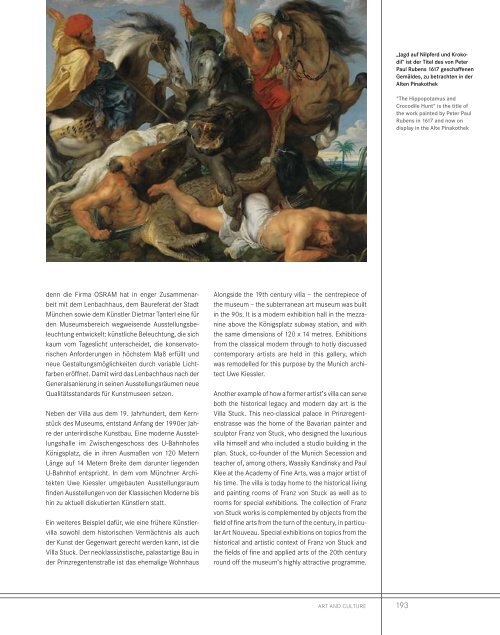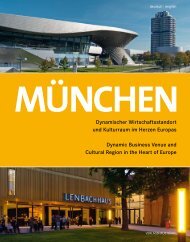München - Dynamischer Wirtschaftsstandort und Kulturraum im Herzen Europas
You also want an ePaper? Increase the reach of your titles
YUMPU automatically turns print PDFs into web optimized ePapers that Google loves.
„Jagd auf Nilpferd <strong>und</strong> Krokodil“<br />
ist der Titel des von Peter<br />
Paul Rubens 1617 geschaffenen<br />
Gemäldes, zu betrachten in der<br />
Alten Pinakothek<br />
"The Hippopotamus and<br />
Crocodile Hunt" is the title of<br />
the work painted by Peter Paul<br />
Rubens in 1617 and now on<br />
display in the Alte Pinakothek<br />
denn die Firma OSRAM hat in enger Zusammenarbeit<br />
mit dem Lenbachhaus, dem Baureferat der Stadt<br />
<strong>München</strong> sowie dem Künstler Dietmar Tanterl eine für<br />
den Museumsbereich wegweisende Ausstellungsbeleuchtung<br />
entwickelt: künstliche Beleuchtung, die sich<br />
kaum vom Tageslicht unterscheidet, die konservatorischen<br />
Anforderungen in höchstem Maß erfüllt <strong>und</strong><br />
neue Gestaltungsmöglichkeiten durch variable Lichtfarben<br />
eröffnet. Damit wird das Lenbachhaus nach der<br />
Generalsanierung in seinen Ausstellungsräumen neue<br />
Qualitätsstandards für Kunstmuseen setzen.<br />
Neben der Villa aus dem 19. Jahrh<strong>und</strong>ert, dem Kernstück<br />
des Museums, entstand Anfang der 1990er Jahre<br />
der unterirdische Kunstbau. Eine moderne Ausstellungshalle<br />
<strong>im</strong> Zwischengeschoss des U-Bahnhofes<br />
Königsplatz, die in ihren Ausmaßen von 120 Metern<br />
Länge auf 14 Metern Breite dem darunter liegenden<br />
U-Bahnhof entspricht. In dem vom Münchner Architekten<br />
Uwe Kiessler umgebauten Ausstellungsraum<br />
finden Ausstellungen von der Klassischen Moderne bis<br />
hin zu aktuell diskutierten Künstlern statt.<br />
Ein weiteres Beispiel dafür, wie eine frühere Künstlervilla<br />
sowohl dem historischen Vermächtnis als auch<br />
der Kunst der Gegenwart gerecht werden kann, ist die<br />
Villa Stuck. Der neoklassizistische, palastartige Bau in<br />
der Prinzregentenstraße ist das ehemalige Wohnhaus<br />
Alongside the 19th century villa – the centrepiece of<br />
the museum – the subterranean art museum was built<br />
in the 90s. It is a modern exhibition hall in the mezzanine<br />
above the Königsplatz subway station, and with<br />
the same d<strong>im</strong>ensions of 120 x 14 metres. Exhibitions<br />
from the classical modern through to hotly discussed<br />
contemporary artists are held in this gallery, which<br />
was remodelled for this purpose by the Munich architect<br />
Uwe Kiessler.<br />
Another example of how a former artist’s villa can serve<br />
both the historical legacy and modern day art is the<br />
Villa Stuck. This neo-classical palace in Prinzregentenstrasse<br />
was the home of the Bavarian painter and<br />
sculptor Franz von Stuck, who designed the luxurious<br />
villa h<strong>im</strong>self and who included a studio building in the<br />
plan. Stuck, co-fo<strong>und</strong>er of the Munich Secession and<br />
teacher of, among others, Wassily Kandinsky and Paul<br />
Klee at the Academy of Fine Arts, was a major artist of<br />
his t<strong>im</strong>e. The villa is today home to the historical living<br />
and painting rooms of Franz von Stuck as well as to<br />
rooms for special exhibitions. The collection of Franz<br />
von Stuck works is complemented by objects from the<br />
field of fine arts from the turn of the century, in particular<br />
Art Nouveau. Special exhibitions on topics from the<br />
historical and artistic context of Franz von Stuck and<br />
the fields of fine and applied arts of the 20th century<br />
ro<strong>und</strong> off the museum’s highly attractive programme.<br />
ART and culture 193




